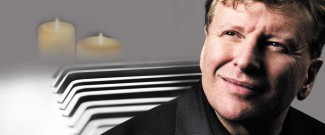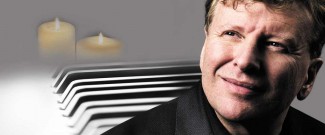Concert Review: Chopin By Candlelight/ Piers Lane

Piers Lane gave a mesmerising performance of Chopin by Candlelight in Sydney last week as part of a national tour. The transcendental experience was built on three elements – Piers Lane’s understated but brilliantly virtuosic style and sensitive playing, the achingly beautiful music of Chopin and the simple ambience created by the minimal lighting in the City Recital Hall. There was no option but to be wrapped in the darkness and become completely immersed in the music.
Jon Buswell’s lighting design created an inviting glow from within the Steinway Concert grand piano which was flanked by four candelabra, evoking the ambience of an 19th century salon. The audience enveloped itself in the darkness and focussed on nothing but the music. There was no possibility of peeking at the programme and in his welcome speech, Lane graciously and sensibly requested that applause be held until the end of each half of the concert to allow an uninterrupted flow of ideas and music. Undoubtedly, the affirmation of applause is important to performers and cathartic for audiences, but there is a great deal to be said for allowing the music to finish speaking.
Lane explained that the 10 pieces he had selected represented works from across Chopin’s brief but blazing output. It was a welcome strategy to hear a recital that focussed on the works of a single composer. Chopin’s music is indeed rich and complex enough in its diversity to curate such a programme without generating boredom.
Lane opened his programme with the Impromptu No 1 in A Flat major Op 29 (1837) creating a bright and feather-light chromatic perpetuum mobile anchored with columns of chords in the contrasting central sostenuto section. It was followed by the devilishly difficult, improvisatory Fantasie in F minor op 49 (1841) introduced in sombre tones which plunged into a meticulous marching rhythm tempered with passages of sweetness and optimism.
If there were ‘popular favourites’ in the programme, they were perhaps the Etude in E major Op 10 No 3 (‘Tristesse’) 1832, its seamless slow cantabile performed without sentimentality and the
Ballade No 3 in A flat major Op 47 (1841) which Lane performed with great dramatic effect, using Chopin’s lyrical elements to powerfully tell the tale of the nymph and her lover.
An effervescent rendition of the Scherzo No 4 in E major Op 54 (1842) ended the first half of the concert with the audience finally able to unleash its appreciation.
Lane opened the second half of his recital with two dance forms – the fiery and fantastic Polonaise in F sharp minor (1841) and the Mazurka Op 17 No 4 1832-33. The Nocturne opus 62 No 1 in B major (1846) was a gratifying inclusion as an example of Chopin’s contrapuntal style, followed by its companion piece, the intensely melodic Nocturne opus 62 No 2 in E major.
Undoubtedly, each one in the audience would have had their own favourite from this programme of gems. Mine came at the very end – the expansive Barcarolle Op 60, (1845-6), reminiscent of Venice with its poetic melody underpinned by harmonies in 3rds and 6ths, passionate ornamentation and gently rocking bass.
For two hours, Lane unfolded Chopin’s world of music, tracing the evolution of his style and treating the audience to the panoramic emotions, technical feats, innovative leaps and nationalist sentiments of his music. Lane generously sat down to two encores. The audience was enraptured.
Shamistha de Soysa for SoundsLikeSydney©

